code flow - events
Exclusive Preview - Episode "Protest"
3 October 2007, 18h30
at
 EPISODE TWO: Protest
EPISODE TWO: Protest
Premieres Sunday, November 4, 2007, at 10:00 p.m. ET
Episode Description
How do contemporary artists engage politics, inequality, and the many conflicts that besiege the world today? How do artists use their work to discuss or oppose misery, turmoil, and injustice? This episode examines the ways in which contemporary artists picture and question war, express outrage, and empathize with the suffering of others. Whether bearing witness to tragic events, presenting alternative histories, or engaging in activism, the artists interviewed in Episode Two use visual art as a means to provoke personal transformations and question social revolutions.
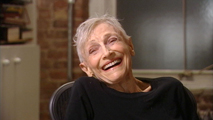 For decades, Nancy Spero has drawn from the political to create compelling works of art that make a statement against war, the abuse of power and our male-dominated society. Regarding her paintings made during the Vietnam War, Spero says: “I guess maybe my art can be said to be a protest…The War paintings are certainly a protest because it was done with indignation.”
For decades, Nancy Spero has drawn from the political to create compelling works of art that make a statement against war, the abuse of power and our male-dominated society. Regarding her paintings made during the Vietnam War, Spero says: “I guess maybe my art can be said to be a protest…The War paintings are certainly a protest because it was done with indignation.”  Spero further explains how the politically-inspired work of her late husband, Leon Golub, not only stimulated, but also posed a challenge for her own work. “It was pretty damned difficult contending with someone who was so…brilliant,” she says. In contrast to Golub’s large-scale paintings, Spero began to work with small, almost microscopic figures, which she describes as “a retort to the large works of the mostly male New York artists.” Viewers observe Spero as she modifies pieces from her previous paintings and prints – including images of severed heads from her War paintings – to produce such works as Cri du Coeur (2005), for which she employs repetition of the image of an ancient Egyptian woman to create a funereal-like procession along the walls rimming her New York gallery.
Spero further explains how the politically-inspired work of her late husband, Leon Golub, not only stimulated, but also posed a challenge for her own work. “It was pretty damned difficult contending with someone who was so…brilliant,” she says. In contrast to Golub’s large-scale paintings, Spero began to work with small, almost microscopic figures, which she describes as “a retort to the large works of the mostly male New York artists.” Viewers observe Spero as she modifies pieces from her previous paintings and prints – including images of severed heads from her War paintings – to produce such works as Cri du Coeur (2005), for which she employs repetition of the image of an ancient Egyptian woman to create a funereal-like procession along the walls rimming her New York gallery.
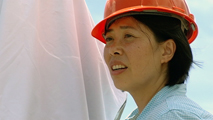 Landscape photographer An-My Lê is fascinated by military war exercises. Traveling around the world, she uses a wooden Deardorff camera to capture black and white images of various military exercises, and explores their connection to the surrounding landscape. “I think my main goal is to try to photograph landscape in such a way so that history could be suggested through the landscape, whether industrial history or my personal history,” she says.
Landscape photographer An-My Lê is fascinated by military war exercises. Traveling around the world, she uses a wooden Deardorff camera to capture black and white images of various military exercises, and explores their connection to the surrounding landscape. “I think my main goal is to try to photograph landscape in such a way so that history could be suggested through the landscape, whether industrial history or my personal history,” she says. 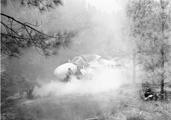 Lê discusses her return to Vietnam, where she grew up amid the violence of the Vietnam War, to photograph people’s activities, revisit childhood memories, and reconnect with her homeland, as well as her experience photographing military re-enactors, whom she found on the Internet. Unable to travel to Iraq to document current U.S. incursions in the Middle East, Lê worked with marines training at Marine Corps Base Camp Pendleton in California photographing the end stages of preparatory war activities. “I think I’ve always tried to understand what is the meaning of war and what does it really mean to live through times of turbulence,” says Lê. “I think a lot of those questions sort of fuel my work.”
Lê discusses her return to Vietnam, where she grew up amid the violence of the Vietnam War, to photograph people’s activities, revisit childhood memories, and reconnect with her homeland, as well as her experience photographing military re-enactors, whom she found on the Internet. Unable to travel to Iraq to document current U.S. incursions in the Middle East, Lê worked with marines training at Marine Corps Base Camp Pendleton in California photographing the end stages of preparatory war activities. “I think I’ve always tried to understand what is the meaning of war and what does it really mean to live through times of turbulence,” says Lê. “I think a lot of those questions sort of fuel my work.”
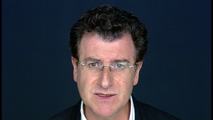 “I strongly believe in the power of a single idea,” says Alfredo Jaar. “My imagination starts working based on research, based on a real life event, most of the time a tragedy that I’m just starting to analyze, to reflect on…this real life event to which I’m trying to respond.” Through his work, Jaar explores both the public’s desensitization to images and the limits of art to represent events such as genocide. For his longest project to date, Jaar spent six years creating 21 different pieces about Rwanda’s horrific realities.
“I strongly believe in the power of a single idea,” says Alfredo Jaar. “My imagination starts working based on research, based on a real life event, most of the time a tragedy that I’m just starting to analyze, to reflect on…this real life event to which I’m trying to respond.” Through his work, Jaar explores both the public’s desensitization to images and the limits of art to represent events such as genocide. For his longest project to date, Jaar spent six years creating 21 different pieces about Rwanda’s horrific realities. 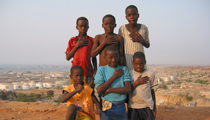 Art21 follows and films Jaar in his native Chile during a major retrospective of his work, which he shares for the first time with the Chilean public – a triumphant and moving homage in his homeland after leaving to live abroad shortly after the Pinochet regime’s military coup. Viewers learn about the stories behind such works as The Silence of Nduwayezu (1997), an installation that tells the tragic story of one young boy from a Rwanda refugee camp who witnessed the murder of both of his parents, and Let One Hundred Flowers Bloom (2005), based on a Chinese poem used by Chairman Mao. The piece features 100 flowers being subjected to “contradictory forces” – sunlight and water, but also industrial-strength winds – serving as a metaphor for the suppression of intellectual voices during Mao’s Hundred Flowers Campaign in the late 1950s. Fed by his background in magic, theater and architecture, Jaar’s works create connections that enlarge comprehension of events that are often hidden from the public. “For me, the heart of an exhibition is really the spirit of the artist; the spirit of what he’s trying to communicate.”
Art21 follows and films Jaar in his native Chile during a major retrospective of his work, which he shares for the first time with the Chilean public – a triumphant and moving homage in his homeland after leaving to live abroad shortly after the Pinochet regime’s military coup. Viewers learn about the stories behind such works as The Silence of Nduwayezu (1997), an installation that tells the tragic story of one young boy from a Rwanda refugee camp who witnessed the murder of both of his parents, and Let One Hundred Flowers Bloom (2005), based on a Chinese poem used by Chairman Mao. The piece features 100 flowers being subjected to “contradictory forces” – sunlight and water, but also industrial-strength winds – serving as a metaphor for the suppression of intellectual voices during Mao’s Hundred Flowers Campaign in the late 1950s. Fed by his background in magic, theater and architecture, Jaar’s works create connections that enlarge comprehension of events that are often hidden from the public. “For me, the heart of an exhibition is really the spirit of the artist; the spirit of what he’s trying to communicate.”
 Using high-powered projectors, Jenny Holzer projects text (often poetry) onto surfaces ranging from the canals of Venice to the ceiling of the Mies van der Rohe Neue Nationalgalerie building in Berlin, illustrating the power of language to evoke deep emotion. Holzer discusses the concepts behind some of her most well-known projects, including For 7 World Trade (2006), for which she projected text onto a glass wall of the lobby. Holzer chose words – which appeared to float across the wall – about the joys of living in New York City as opposed to “memorial text” in response to 9/11. However, much of Holzer’s work focuses on devastation and cruelty, and uses the words of others. “I stopped writing my own text in 2001,” she explains.
Using high-powered projectors, Jenny Holzer projects text (often poetry) onto surfaces ranging from the canals of Venice to the ceiling of the Mies van der Rohe Neue Nationalgalerie building in Berlin, illustrating the power of language to evoke deep emotion. Holzer discusses the concepts behind some of her most well-known projects, including For 7 World Trade (2006), for which she projected text onto a glass wall of the lobby. Holzer chose words – which appeared to float across the wall – about the joys of living in New York City as opposed to “memorial text” in response to 9/11. However, much of Holzer’s work focuses on devastation and cruelty, and uses the words of others. “I stopped writing my own text in 2001,” she explains. 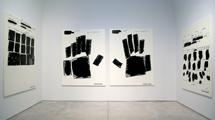 “I found that I couldn’t say enough adequately and so it was with great pleasure that I went to the text of others.” Viewers observe Holzer creating new work as she prepares an exhibition of paintings and prints of declassified, redacted government documents, some of which are letter-size, while others are blown-up to an overwhelming scale “…in hopes that people will recoil,” she says. “I want to be able to continue to work, to pull from good and ghastly text, to offer these to people and to present them in ways that are lovely and exacting.”
“I found that I couldn’t say enough adequately and so it was with great pleasure that I went to the text of others.” Viewers observe Holzer creating new work as she prepares an exhibition of paintings and prints of declassified, redacted government documents, some of which are letter-size, while others are blown-up to an overwhelming scale “…in hopes that people will recoil,” she says. “I want to be able to continue to work, to pull from good and ghastly text, to offer these to people and to present them in ways that are lovely and exacting.”
Artist Biographies
NANCY SPERO was born in Cleveland, Ohio in 1926. She received a BFA from the School of the Art Institute of Chicago (1949), and honorary doctorates from the School of the Art Institute of Chicago (1991) and Williams College (2001). Spero is a pioneer of feminist art. Her work since the 1960s is an unapologetic statement against the pervasive abuse of power, Western privilege, and male dominance. Executed with a raw intensity on paper and in ephemeral installations, her work often draws its imagery and subject matter from current and historical events such as the torture of women in Nicaragua, the extermination of Jews in the Holocaust, and the atrocities of the Vietnam War. Spero samples from a rich range of visual sources of women as protagonists – from Egyptian hieroglyphics, 17th Century French history painting, and Frederick’s of Hollywood lingerie advertisements. Her figures, in full command of their bodies, co-existing in nonhierarchical compositions on monumental scrolls, visually reinforce principles of equality and tolerance. Spero was elected to the American Academy of Arts and Letters (2006). Awards include a Lifetime Achievement Award from the College Art Association (2005); the Honor Award from the Women’s Caucus for Art (2003); the Hiroshima Art Prize (jointly with Leon Golub, 1996); and the Skowhegan Medal (1995). Major exhibitions include Centro Galego de Arte Contemporanea, Santiago de Compostela, Spain (2003); MIT List Visual Arts Center, Cambridge, Massachusetts (1994); Institute of Contemporary Art, Boston (1994); Museum of Modern Art, New York (1992); and the Museum of Contemporary Art, Los Angeles (1988). Spero lives and works in New York.
AN-MY LÊ was born in Saigon, Vietnam in 1960. Lê fled Vietnam with her family as a teenager in 1975, the final year of the war, eventually settling in the United States as a political refugee. Lê received BAS and MS degrees in biology from Stanford University (1981, 1985) and an MFA from Yale University (1993). Her photographs and films examine the impact, consequences, and representation of war. Whether in color or black-and-white, her pictures frame a tension between the natural landscape and its violent transformation into battlefields. Projects include Viêt Nam (1994-98), in which Lê’s memories of a war-torn countryside are reconciled with the contemporary landscape; Small Wars (1999-2002), in which Lê photographed and participated in Vietnam War reenactments in South Carolina; and 29 Palms (2003-04) in which United States Marines preparing for deployment play-act scenarios in a virtual Middle East in the California desert. Suspended between the formal traditions of documentary and staged photography, Lê’s work explores the disjunction between wars as historical events and the ubiquitous representation of war in contemporary entertainment, politics, and collective consciousness. She has received many awards, including fellowships from the John Simon Guggenheim Memorial Foundation (1997) and the New York Foundation for the Arts (1996). She has had major exhibitions at the San Francisco Museum of Modern Art (2006); Henry Art Gallery, Seattle (2006); ICP Triennial (2006); P.S. 1 Contemporary Art Center, Long Island City (2002); and the Museum of Modern Art, New York (1997). Lê lives and works in New York.
(cont.) 3
ALFREDO JAAR was born in Santiago, Chile in 1956. He received degrees from Instituto Chileno-Norteamericano de Cultura, Santiago (1979) and Universidad de Chile, Santiago (1981). In installations, photographs, film, and community-based projects, Jaar explores the public’s desensitization to images and the limitations of art to represent events such as genocides, epidemics, and famines. Jaar’s work bears witness to military conflicts, political corruption, and imbalances of power between industrialized and developing nations. Subjects addressed in his work include the holocaust in Rwanda, gold mining in Brazil, toxic pollution in Nigeria, and issues related to the border between Mexico and the United States. Many of Jaar’s works are extended meditations or elegies, including Muxima (2006) (a video that portrays and contrasts the oil economy and extreme poverty of Angola) and The Gramsci Trilogy (2004-05) (a series of installations dedicated to the Italian philosopher Antonio Gramsci, who was imprisoned under Mussolini’s Fascist regime). Jaar has received many awards, including a John D. and Catherine T. MacArthur Foundation Award (2000); a Louis Comfort Tiffany Foundation Award (1987); and fellowships from the National Endowment for the Arts (1987); and the John Simon Guggenheim Memorial Foundation (1985). He has had major exhibitions at the Museum of Fine Arts, Houston (2005); Museo d’Arte Contemporanea, Rome (2005); MIT List Visual Arts Center, Cambridge, Massachusetts (1999); and the Museum of Contemporary Art, Chicago (1992). Jaar emigrated from Chile in 1981, at the height of Pinochet’s military dictatorship. His exhibition at Fundación Telefonica Chile, Santiago (2006) is his first in his native country in twenty-five years. Jaar lives and works in New York.
JENNY HOLZER was born in Gallipolis, Ohio in 1950. She received a BA from Ohio University in Athens (1972); an MFA from the Rhode Island School of Design, Providence (1977); and honorary doctorates from the University of Ohio (1993), the Rhode Island School of Design (2003), and New School University, New York (2005). Whether questioning consumerist impulses, describing torture, or lamenting death and disease, Jenny Holzer’s use of language provokes a response in the viewer. While her subversive work often blends in among advertisements in public space, its arresting content violates expectations. Holzer’s texts – such as the aphorisms “abuse of power comes as no surprise” and “protect me from what I want” – have appeared on posters and condoms, and as electronic LED signs and projections of xenon light. Holzer’s recent use of text ranges from silk-screened paintings of declassified government memoranda detailing prisoner abuse, to poetry and prose in a 65-foot wide wall of light in the lobby of 7 World Trade Center, New York. She has received many awards, including the Golden Lion from the Venice Biennale (1990); the Skowhegan Medal (1994); and the Diploma of Chevalier (2000) from the French government. Major exhibitions include the Neue Nationalgalerie, Berlin (2001); Contemporary Arts Museum, Houston (1997); Dia Art Foundation, New York (1989); and the Solomon R. Guggenheim Museum, New York (1989). Since 1996, Holzer has organized public light projections in cities worldwide. She was the first woman to represent the United States in the Venice Biennale (1990). Jenny Holzer lives and works in Hoosick Falls, New York.Premieres on PBS (in the US) on Sunday, October 28, 2007, at 10:00 p.m. ET
Episode Description
What role do intuition, emotion, fantasy, and escapism play in contemporary art? How do contemporary artists respond to traditionally romantic ideals such as sentimentality, pathos, and the philosophy of art for art’s sake? Episode One poses questions about the value of pleasure in art and features artists whose works are extended meditations on mortality, love, reality and make-believe.
Early in her career, Laurie Simmons used photography as a tool to create a still and pristine reality – with images that played with dollhouse-sized furniture or a pair of high heels – in contrast to the chaos of everyday life. Simmons explains how she was able to bring her still photographs to life in her recent and first feature film, The Music of Regret (2006). Drawing from the American Songbook tradition, Simmons composed lyrics and storylines for the musical, which featured a cast of puppets, dummies, and dancers. “My inner life about my own work was very theatrical and very narrative, but that’s something I was always afraid to express,” says Simmons. “I had music in my head that was sort of playing while I was shooting.” Viewers follow Simmons through portions of the three-act musical, which portrays complex emotions of love, loss, and regret. Inspired by three different stages of Simmons’s photographic work, the film features hand puppets, ventriloquist dummies and objects that come to life and enact scenes that resemble real life. In the first Act, “The Green Tie,” Simmons employs puppets to explore love and conflict among family and suburban neighbors. In Act Two, “The Music of Regret,” Academy Award-winning actress Meryl Streep portrays a “live” puppet, whose interaction with a ventriloquist dummy depicts a bittersweet relationship through their love song duets. In the film’s third and final Act, “The Audition,” Simmons works with members of the Alvin Ailey American Dance Theater to produce a stage performance that features everyday objects – a pocket watch, a camera, a birthday cake – dancing tango, tap and ballet at an audition before an unseen judge. “Regret is the prevailing emotion…that brings the three Acts together,” she says, “…it ends on a note of…what might have been, if I just had a chance.”
Lari Pittman was born and works in Los Angeles. His references and background which inspire his work include the freedom and chaos of the city, his memories of growing up in Columbia and his “very, very strong Mediterranean core.” His meticulously-layered paintings transform decoration, pattern, and signage into elaborate scenes that illustrate complexity, difference, and desire. “I want to offer a painting that somehow…the viewer has to stand in front of it and almost not believe it,” says Pittman. “But in the act of not believing it, what they’re actually seeing, they get swept away in it.” As the documentary follows Pittman, he recounts a fond childhood memory from his early life in South America, and the encouragement and love he received as a young boy from his family, both of which he credits with his ability to grow, mature, and develop as a visual artist. “I think that that’s why the decorative aspect of the work comes systemically, organically, naturally to me because it was really allowed to bloom and blossom and wasn’t curtailed or curbed when I was a child.” Despite a charmed childhood, Pittman explains that what keeps him “radicalized” is an awareness of this country’s attitude towards the gay community. “I can lead quite a pretty life,” he says, “but it’s always quickly clarified by those very aggressive strains in American culture, which in a way…wonderfully puts me in my place.” He also explains how he draws inspiration from religious images and retablos as well as gardening and landscaping. “I don’t respond to the idea of nature at large. I prefer landscaping,” says Pittman, “…landscaping as a way to push back, a little bit, the chaos of nature…the kind of violence of it.”
Born in England, Judy Pfaff came to America when she was twelve and later attended Yale University School of Art. Although she started out as a painter, Pfaff was drawn to materials and sculpture. As she explains, “I found when I was a painter I couldn’t stop and until it was finished another thought didn’t enter. With the sculpture, they go on for months. It tells different kinds of stories. They’re sort of sequence moments. It worked better for the way I am put together.” Balancing intense planning with improvisational decision-making on site, Pfaff creates exuberant, sprawling sculptures and installations that blend landscape, architecture, and synthetic color into a tense yet organic whole. The documentary follows Pfaff through the installation of a recent exhibition, one which is driven by sadness and loss, using tree roots, neon tubes, and plaster forms, among others, to explore the worlds of black and white. Pfaff describes how the show came into being after the deaths of several close friends, her mother, and her former teacher and mentor, Al Held. “Last year, everyone I knew died,” she says. “I just thought, this show…I just want it to be emotional. So I was basing this sort of on images of…I don’t think hell, but darkness and kind of a wilder characteristic than other stuff.”
“As I start a project, I always need to create a world. Then I want to enter this world, and my walk through this world is the work,” says Pierre Huyghe, who lives in both Paris and New York. Cultivating folly, leisure, and celebration as the means for creating art, Huyghe’s films, installations, and public events range from a small-town parade to a puppet theater, from a model amusement park to an expedition in Antarctica. “I’m trying to be less narrative, it’s more an emotional landscape that I’m trying to reach here,” he explains. Huyghe describes how, through the documentation of his scripted realities, he is “building a kind of mythology,” and using humor to “break even the possibility of critical judgment.” Huyghe believes that his exhibitions are not the endpoint, but rather “the starting point to go somewhere else.”
Art:21 Season 4 consists of four episodes: Romance, Protest, Ecology, Paradox. The first two are being screened on 3 October in our exclusive preview at F+F School, Zurich.
The material on this page is copyrighted by Art 21 Inc. and PBS and used with permission in the context of the preview organized by code flow in Zurich.